
Nato il 09/12/1909 a Trani (Foggia), Vittorio Romandini e’ tra i primi piloti che arrivano a Gorizia con il 4° Stormo. Partecipa con la Pattuglia Acrobatica alle manifestazioni di Budapest nel 1936 e 1937, a Belgrado nel 1938. Nel 1938 parte per la Campagna di Spagna (Baleari). Insieme alll’inseparabile Renzi, forma una coppia famosa che infonde ovunque allegria e simpatia. Dopo l’8 settembre 1943 fa parte del GTV (Gruppo Trasporto Velivoli) con base a Gorizia e durante un trasferimento velivolo in coppia con Montanari, da Rimini a Gorizia, a causa della scarsa visibilita’ o di una avaria, e’ costretto ad un atterraggio di fortuna nei campi ma un fosso seminascosto ferma violentemente la corsa del velivolo e Romandini rimane gravemente ferito al volto. Viene soccorso da due militari tedeschi che lo trasportano all’ospedale di Chioggia dove muore dopo breve agonia il 13-11-1943.
Renzi e Romandini sono ricordati come una coppia di piloti inseparabili, sempre allegri e trascinatori ineguagliabili nelle feste e balli cui partecipavano nei paesi intorno a Gorizia. Inseparabili anche nelle esibizioni delle Pattuglie Acrobatiche del 4° Stormo, non potevano non sposarsi che con due ragazze dello stesso paese, San Lorenzo. Purtroppo anche nella sorte sono rimasti uniti ed entrambi deceduti durante la guerra.
GRANDI MANOVRE 1931


AVIANO 1934


GORIZIA



















SPAGNA




ALTRO













Tratto da: Biplane fighter aces
http://surfcity.kund.dalnet.se/italy_romandini.htm
Vittorio Romandini served as a volunteer during the Spanish Civil War. When Italy declared war on the Great Britain and France on 10 June 1940, he served in the 91a Squadriglia, 10o Gruppo, 4o Stormo C.T.
On 12 June, the 2o Stormo’s fighters in North Africa were joined by those of the 10o Gruppo (84a, 90a and 91a Squadriglie) of
the Gorizia based 4o Stormo C.T.. The Gruppo was commanded by Tenente Colonnello Armando Piragino and started the war at Tobruk T2 with 27 CR.42s.
The 91a Squadriglia C.T. was composed of the following pilots: Capitano Giuseppe D’Agostinis (CO), Tenente Enzo Martissa, Sottotenente Ruggero Caporali, Maresciallo Raffaele Chianese, Maresciallo Romandini, Sergente Maggiore Leonardo Ferrulli, Sergente Maggiore Lorenzo Migliorato, Sergente Maggiore Natale Fiorito, Sergente Maggiore Elio Miotto, Sergente Aldo Rosa, Sergente Alessandro Bladelli, Sergente Guido Scozzoli and Sergente Luigi Ferrario. They had ten CR.42s on strength (including Piragino’s).
Nine aircraft from both 113 and 55 Squadrons were briefed to attack the airfields of El Adem and El Gubbi at dawn on 16 June. Three Blenheims (L8664, L8397 and L8390) of the latter Squadron failed to reach the target due to engine problems (a penalty of operating from desert airstrips). Reportedly, 25 Italian fighters, which spoiled their aim, heavily engaged those that bombed and although bombs were seen to fall among the parked aircraft, damage was estimate as slight. All bombers returned to base.
It seems that four aircraft (probably fighters) were slightly damaged at T2 and that Tenente Vincenzo Vanni of the 84a Squadriglia was wounded.
During the attack on T2, four pilots (Tenente Enzo Martissa, Maresciallo Romandini, Sergente Alessandro Bladelli and Sergente Elio Miotto) of the 91a Squadriglia were scrambled immediately. They intercepted three of the Blenheims and claimed two of them shot down. The victories were credited as shared to the four pilots as was common use for the 4o Stormo at this stage of the war. In fact, because of this combat, Martissa was awarded with a Medaglia d’argento al valor militare for bravery and the official motivation of this award stated that he had shot down one of the British bombers individually.
Maresciallo Mario Bandini, Sergente Giuseppe Scaglioni and Sergente Corrado Patrizi (all of the 84a Squadriglia) went to T3 on alarm duty and met six bombers coming back from that airfield. Bandini single-handed attacked the British planes claiming one of them. During the attack, he was wounded in the left arm by return fire but succeeded in coming back to T2 and displaying great calm, made a perfect landing and a complete debriefing before being carried to Tobruk’s hospital. Bandini was also awarded a Medaglia d’Argento al valor militare for bravery for this mission.
Scaglioni and Patrizi meanwhile attacked two Blenheims, empting their guns on them without seeing their opponents going down.
The only reported intercepted British bomber was Blenheim Mk.I L8531 from 55 Squadron flown by Flying Officer M. F. H. Fox (Observer Sergeant Nicholas and Wireless Operator/Air Gunner Leading Aircraftman Klines), which reported being attacked by a fighter that followed it opening fire and hitting both spars of the mainplane, the radio set and the stern frame. The plane was however able to return to Fuka without difficulty. Nothing is known about 113 and 211 Squadrons because of the total lack of records of these units for the period.
